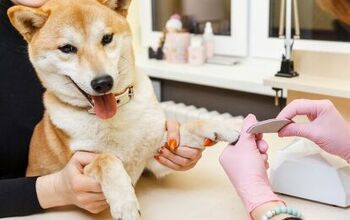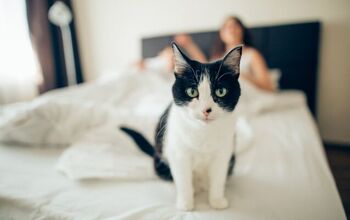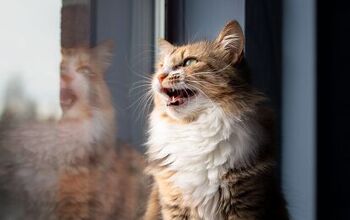5 Interesting Facts About Tabby Cats

One of the most popular kinds of cat, the Tabby is a fascinating feline. But we bet you didn’t know these facts about tabby cats.
Cats can have a variety of coat colors and patterns, and tabby is one that you will recognize easily when you see it. Unlike kitties with coats that are one solid color, tabbies have fur that boasts a lovely pattern that sets them apart.
You might have met a tabby cat at an animal shelter or through a friend or family member, or you might even have a tabby to call your own. Cute and loveable, with amusing personalities, tabbies are just like other frisky felines, but there are some fun facts that make them even more fascinating.
Sure, tabby cats may look like your average domesticated feline, but they have their own uniqueness, and a few interesting facts about these kitties are listed below so you can get to know them a bit better.
Tabby Is a Pattern, Not a Breed
Tabby refers to a cat’s coat pattern, so it is not considered a breed of its own. This is actually the most common coat, and it can be found on kitties across a wide range of breeds. So, this means that you can encounter a purebred kitty with a tabby coat and a mixed breed cat with the same pattern. Of course, purebred cats will have other distinguishing features as well.
Related: Top 10 Long Haired Cat Breeds
Some of the many breeds that can showcase the tabby pattern include the American Shorthair, the Persian, the Egyptian Mau, the Maine Coon, the Norwegian Forest Cat, the Abyssinian, the American Curl, and the Siberian.
Because this coat pattern is found across so many feline breeds, these cats can have a range of personalities too. After all, certain feline breeds are known for having particular traits, so just because two cats have tabby coats does not mean that they will also have the same temperament, likes, dislikes, habits, etc.
There Isn’t Just One Tabby Pattern
Speaking of coat patterns and features, another interesting fact is that the tabby coat could actually come in several attractive patterns. As you will see below, not all tabby kitties will look the same. In fact, you could meet two tabbies that look totally different from one another, based on features like their stripes and spots.
Here is a basic breakdown of the different tabby patterns:
- The mackerel tabby cat will feature stripes on the body, as well as on the legs, chest, and tail. The stripes will run from the belly to the spine. This is the pattern that most people think of when they think of tabby felines.
- The spotted tabby will feature spots rather than stripes. The spots could be small or large, and they could be round or oval.
- Instead of showcasing stripes or spots, the classic tabby will have thick swirls on the body. This distinct pattern is also referred to as the marbled tabby.
- The ticked tabby is also known as the agouti tabby pattern. You won’t find spots or stripes within this pattern, but there will be typical tabby markings on the face, along with agouti hairs on the body. This means that every hair will feature both dark and light bands of color. A great example is the Abyssinian.
- The patched tabby pattern can be found on tortoiseshell kitties (also known as torties). These cats will typically have more than one color throughout the coat, such as black and orange, and those colors appear in patches. But you may be able to see a tabby pattern as well, particularly on certain parts of the body, such as on the legs. If a kitty has both a tortoiseshell and a tabby coat, they are referred to as a torbie.
Related: Crafting with Cat Fur? Yeah, It’s a Thing.
Tabbies Can Feature Any Color
In addition to eye-catching patterns, tabby kitties could also feature various coat colors. These include brown, brown/gray, gray, cream, buff, and orange. So, if you love the look of tabby cats because they are so beautiful, but you also prefer cats that have a particular coat color, such as orange, you can find kitties that have both characteristics.
The Tabby Pattern Has an Interesting History
When researchers analyzed the DNA of cats that lived thousands of years ago, what they realized was that the tabby coat did not actually show up until the Middle Ages. And it took until the 18th century for the tabby pattern to become more common amongst kitties. Other than that, cats haven’t changed much at all since ancient times.
They Have an “M” on Their Forehead
This might be one of the lesser-known facts about tabbies, and a lot of people who have been around cats for a long time might not even know about it until it is pointed out to them. Basically, when you look closely at a tabby cat, you will notice an “M” as part of the pattern on the forehead.
Like the rest of the coat pattern, this cute feature is simply a part of the cat’s genetic makeup. And this “M” could be faint and blended in with the rest of the fur on a cat’s face, or it could be pretty obvious because it is dark enough to stand out against the rest of the pattern. If you have never picked up on it before and you have a tabby in your family, take a look at your pet’s forehead to look for this feature. Once you see it, it will be even easier to recognize it on other kitties.
Thinking About Adopting a Tabby Cat?
As you can see, there are quite a few things about tabbies that make them such attention-grabbing and attractive kitties. And now that you know more about these cats, you might be considering adding one to your family. If that’s the case, adopting one from a local shelter or rescue group is certainly an option, and you can also find purebred tabby kitties in need of a home if you search specifically for them.
If you want a tabby kitty to call your own, you might not have trouble finding one. These cats are easy to find in shelters and foster networks around the world, so, again, if you are thinking about introducing one of these beautiful kitties into your family, consider adopting one who is searching for their forever home.

Lisa Selvaggio is a freelance writer and editor, and our resident cats-pert, with certifications in pet nutrition and pet first aid. She enjoys producing content that helps people understand animals better so they can give their pets a safe and happy home.
More by Lisa Selvaggio























